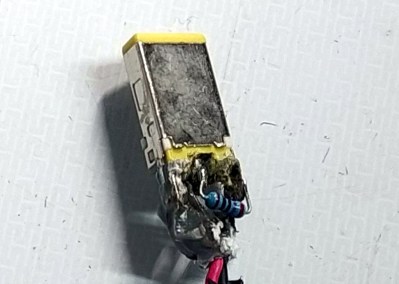USB-C has brought the world much more powerful charging options in a slimline connector. With laptop chargers and portable battery packs using the standard, many with older hardware are converting their devices over to work with USB-C. [victorc] was trying to do just that, purchasing an adapter cable to charge a ThinkPad. Things didn’t quite work out of the box, so some hacking was required.
 The problem was the power rating of the adapter cable, versus the battery pack [victorc] was trying to use. In order to allow the fastest charging rates, the adapter cable features a resistor value which tells the attached Lenovo laptop it can draw up to 90 W. The battery pack in question could only deliver 45 W, so it would quickly shut down when the laptop tried to draw above this limit.
The problem was the power rating of the adapter cable, versus the battery pack [victorc] was trying to use. In order to allow the fastest charging rates, the adapter cable features a resistor value which tells the attached Lenovo laptop it can draw up to 90 W. The battery pack in question could only deliver 45 W, so it would quickly shut down when the laptop tried to draw above this limit.
To rectify this, [victorc] looked up the standard, finding the correct resistor value to set the limit lower. Then, hacking open the cable, the original resistor on the Lenovo connector was removed, and replaced with the correct value. With this done, the cable works perfectly, and [victorc] is able to charge their laptop on the go.
For all the benefits USB-C has brought, there’s been plenty of consternation, too. Whether this clears up, only time will tell!
















This is not an USB-C connector it is Lenovo Slim tip. Already there Is a lot of info about resistors of Lenovo connectors on the following wiki page:
http://www.thinkwiki.org/wiki/Power_Connector
it’s certainly not a ‘Slim Tip to Slim Tip adapter cable’ being shown. it is definitely a ‘USB-C to Slim Tip adapter cable’ shown.
There’s a challenge. Design a serial interface with power where each part along the line can report their power capacity, the information can be probed from the end of the cable, and it’s implemented using only passive components or other jellybean parts that everybody has access to – no programmable digital parts, no ASICs.
Personally I’d prefer if power negotiating had more computing power than an Apollo Guidance Computer.
@kyle, Pfffftt! Put an Arduino in it!
I think that would still literally be more power than an Apollo Guidance Computer, if I’m not mistaken. 😂🤣
Next up, introducing, the DSKYduino….
K.I.S.S.
If it can be done with passives, then it’s both cheap, reliable and easy to fix.
The problem with needing a special chip in every cable is that you can’t make your own cables.
And some chinesium products will come without, or with a counterfeit chip that injects malware into your machine
Current loop, maybe? Each part down the line limits the loop current to its own limit, meaning the weakest link is the one setting the power capacity in the end.
This looks promising: https://en.wikipedia.org/wiki/Constant-current_diode
That’s pretty damn clever. How do you probe it though? If you have ground, power, and some data lines, where’s the current loop?
“[victorc] is able to charge their laptop on the go” – Their?
Yes their is correct as opposed to there.
What are you trying to get at here? Their is the proper form of the word if you are referring to ownership, and while we could perhaps assume that somebody who’s using “Victor” as their handle is male, that’s certainly not a definite these days.
From the Singular “they”: a very old use of the pronoun (and inflections) that became more common recently as a gender neutral alternative to he/she.
There are a few cases where a person is referred in plural form…
– a royalty e.g. The Queen
– a corporation e.g. We at YYZ corporation (even when it was a sole ownership)
– a person in a relationship
– a crazy person with multiple personality
Or if their gender is unknown or non-binary.
Meant “his,” but was grammatically incompetent.
Great way to start a fire… I can’t believe you’re endorsing this hack! Not a good idea.
I have another solution on my Thinkpad X250. Ordered from a clever bloke an internal replacement for the power port and cable. Opened in up, removed the old port and cable and installed the new usb c port and cable, plugged it in and put the lid back on my laptop. Cable is for 45W. He has other ports with different wattage for different models. Worked like a charm and was easy to perform. Nice to have USB charging port on my old Thinkpad
Resistor replacement, pah amateurs, file it down if you need it higher, add graphite if you need it lower. :-D
bah! just add a switch and manually PWM it to stay below 45W (maybe add a choke or something) :-P
No need for a switch – just unplug and replug it really fast!
The charger pictured is not USB-C; it is Lenovo’s rectangular charger plug that is the dimensions of a USB-A connector.
Another option would be to replace the slimline charging port with usb-c like this https://www.reddit.com/r/thinkpad/comments/eehsm9/modded_my_t450s_to_use_usbc_charging/
That is a slim-tip adapter. Not even close to usbc in terms of size and shape.
Yeah. Did you read the article?
You would hope it wouldn’t take a genius to imagine the USB C end of the adapter cable . . .
But here we are.